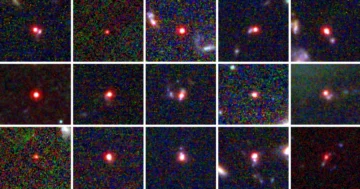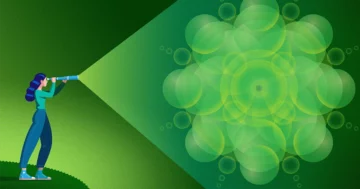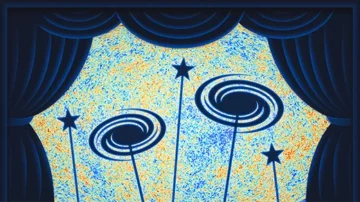
Introduction
In mathematics, a simple problem is often not what it seems. Earlier this summer, Quanta reported on one such problem: What is the smallest area that you can sweep out while rotating an infinitely thin needle in all possible directions? Spin it around its center like a dial, and you get a circle. But rotate it more cleverly, and you can cover an arbitrarily small fraction of space. If you don’t require the needle to move in one continuous motion, and instead simply lay down a needle in every direction, you can construct an arrangement of needles that covers no area at all.
Mathematicians call these arrangements Kakeya sets. While they know that such sets can be small in terms of area (or volume, if you’re arranging your needles in three or more dimensions), they believe the sets must always be large if their size is measured by a metric called the Hausdorff dimension.
Mathematicians have yet to prove this statement, known as the Kakeya conjecture. But while it’s ostensibly a simple question about needles, “the geometry of these Kakeya sets underpins a whole wealth of questions in partial differential equations, harmonic analysis and other areas,” said Jonathan Hickman of the University of Edinburgh.
The Kakeya conjecture lies at the base of a hierarchy of three central problems in harmonic analysis — a branch of mathematics that studies how functions can be represented as sums of periodic functions like regularly oscillating sine waves.
Introduction
The next step up in that hierarchy is the “restriction” conjecture. If it is true, so is the Kakeya conjecture. (This also means that if the Kakeya conjecture turns out to be false, the restriction conjecture can’t be true.) The restriction conjecture, in turn, is implied by the so-called Bochner-Riesz conjecture. And at the very top sits the local smoothing conjecture.
The first two conjectures deal with the behavior of the Fourier transform, a technique in harmonic analysis for, in effect, calculating how to express almost any function as a sum of sine waves. It is one of the most powerful mathematical tools available to physicists and engineers. The Fourier transform has played a fundamental role in solving differential equations, expressing quantum mechanical ideas like the Heisenberg uncertainty principle, and analyzing and processing signals — making things like modern mobile phones possible.
Since each statement in the hierarchy implies the one below it, if the Kakeya conjecture is false, none of the other conjectures are true. The entire tower will come crashing down. “You can create a super monster counterexample that would break a lot of conjectures,” Hickman said.
On the other hand, proving the Kakeya conjecture true wouldn’t automatically imply the truth of those other conjectures — but it would give mathematicians important insights into how to proceed.
And so, “nearly half of the community of harmonic analysis that I know of is working on this and related problems, or has worked on them at some point,” said Shaoming Guo of the University of Wisconsin, Madison.
More recently, mathematicians have discovered, to their surprise, that the techniques they’ve developed to tackle these problems can also be used to prove major results in the seemingly unrelated field of number theory. “It’s a much more general phenomenon than people thought,” Guo said.
Layer Cake
The story starts with the Fourier transform. “You want to decompose [functions] into small pieces, analyze their interactions, and add them back together,” said Yumeng Ou of the University of Pennsylvania. For one-dimensional functions — curves that you can plot on a piece of paper — mathematicians have a good understanding of how to do this, even when they need to reverse the Fourier transform using only some of the pieces.
But in two or more dimensions, things can get messy.
In 1971, Charlie Fefferman, a mathematician at Princeton University, figured out how to use Kakeya sets to demonstrate that reversing the Fourier transform can lead to strange and surprising outcomes in multiple dimensions.
Mathematicians found a fix in the form of the Bochner-Riesz conjecture, which essentially states that there are more sophisticated ways to recover the original function that don’t break down like Fefferman’s example. But that fix depended on the truth of the Kakeya conjecture.
If it’s true, “truncating frequencies will only lead to small errors,” said Betsy Stovall of the University of Wisconsin, Madison. “It means the small errors don’t blow up.”
So began the hierarchy. Later, mathematicians discovered another important connection: If true, the Bochner-Riesz conjecture also implied a statement called the restriction conjecture. This conjecture states that if you start with a limited version of the Fourier transform — “restricting” the values you look at to only those that live on particular surfaces — this can still give you important information about the original function. And it turned out that if the restriction conjecture was true, so was the Kakeya conjecture. (This placed the restriction conjecture between Kakeya and Bochner-Riesz in the tower.)
The crowning problem in the hierarchy, called the local smoothing conjecture, doesn’t deal with the Fourier transform directly, but rather puts bounds on the size of solutions to equations describing the behavior of waves.
You can think of this, too, in terms of the geometry of lines in a Kakeya set. You can break up a general solution to the wave equation into a bunch of pieces that move in different directions and interact with each other in different ways over time. Each of those pieces mathematically resembles a needle in a Kakeya set. The Kakeya conjecture asserts that such a configuration can’t have too much overlap. In this physical context, overlaps would correspond to the persistence of irregular and unexpected behaviors in the solution. For instance, a sound wave could amplify in lots of regions at lots of different times.
The local smoothing conjecture states that such irregularities should average out. “It’s like taking the average of the financial market,” said Ciprian Demeter of Indiana University Bloomington. “There could be crashes here and there, but if you invest your money and retire in 40 years, there’s a good chance you’ll get some good investments.”
But as with all the conjectures in the hierarchy, that depends on the truth of the Kakeya conjecture. “The idea is that if you rule out a lot of intersection in Kakeya sets, that means you can rule out these situations where parts of your solution conspire together to create some sort of blowup,” Stovall said.
This conjecture is the most difficult of the bunch: While the two-dimensional cases of the Kakeya, restriction and Bochner-Riesz problems were solved decades ago, the two-dimensional local smoothing conjecture was only proved a few years ago. (In higher dimensions, all these problems remain open.)
But despite the slow progress on proving the local smoothing conjecture, work on it has led to tremendous progress elsewhere. In 1999, while trying to tackle the conjecture, the mathematician Thomas Wolff introduced a method known as decoupling. Since then, that technique has taken on a life of its own: It’s been used to make major breakthroughs not just in harmonic analysis, but in number theory, geometry and other areas. “Using decoupling results, you now have world records in very famous, important problems,” said Christopher Sogge of Johns Hopkins University, who first formulated the local smoothing conjecture in the 1990s. For instance, decoupling has been used to help count how many ways an integer can be represented as the sum of squares, cubes or some other power.
As Demeter put it, these results are possible because “we can look at numbers as waves.” That all these problems link back to Kakeya needle sets “is fascinating,” he added. “You don’t think that so much beauty, difficulty and importance can be hidden in something that can be formulated using line segments.”
- SEO Powered Content & PR Distribution. Get Amplified Today.
- PlatoData.Network Vertical Generative Ai. Empower Yourself. Access Here.
- PlatoAiStream. Web3 Intelligence. Knowledge Amplified. Access Here.
- PlatoESG. Automotive / EVs, Carbon, CleanTech, Energy, Environment, Solar, Waste Management. Access Here.
- PlatoHealth. Biotech and Clinical Trials Intelligence. Access Here.
- ChartPrime. Elevate your Trading Game with ChartPrime. Access Here.
- BlockOffsets. Modernizing Environmental Offset Ownership. Access Here.
- Source: https://www.quantamagazine.org/a-tower-of-conjectures-that-rests-upon-a-needle-20230912/
- :has
- :is
- :not
- :where
- ][p
- $UP
- 1999
- 40
- a
- About
- AC
- add
- added
- ago
- All
- almost
- also
- always
- an
- analysis
- analyze
- analyzing
- and
- Another
- any
- ARE
- AREA
- areas
- around
- arrangement
- arrangements
- AS
- At
- automatically
- available
- average
- back
- base
- BE
- Beauty
- because
- been
- began
- behavior
- behaviors
- believe
- below
- between
- blow
- bounds
- Branch
- Break
- breakthroughs
- Bunch
- but
- by
- calculating
- call
- called
- CAN
- Can Get
- cases
- Center
- central
- Chance
- Circle
- come
- community
- Configuration
- conjecture
- connection
- construct
- context
- continuous
- could
- cover
- covers
- Crashing
- create
- deal
- decades
- demonstrate
- depends
- Despite
- developed
- different
- difficult
- Difficulty
- Dimension
- dimensions
- direction
- directly
- discovered
- do
- Doesn’t
- Dont
- down
- each
- Earlier
- ed
- Edinburgh
- effect
- elsewhere
- Engineers
- Entire
- equations
- Errors
- essentially
- Even
- Every
- example
- express
- expressing
- false
- famous
- fascinating
- few
- field
- figured
- financial
- Financial Market
- First
- Fix
- For
- form
- found
- fraction
- function
- functions
- fundamental
- General
- geometry
- get
- Give
- good
- Half
- hand
- Have
- he
- help
- here
- Hidden
- hierarchy
- higher
- hopkins
- How
- How To
- HTML
- HTTPS
- i
- idea
- ideas
- if
- implied
- importance
- important
- in
- Indiana
- information
- insights
- instance
- instead
- interact
- interactions
- intersection
- into
- introduced
- Invest
- Investments
- IT
- ITS
- johns
- Johns Hopkins
- Johns Hopkins University
- just
- Know
- known
- large
- later
- lay
- lead
- Led
- lies
- Life
- like
- Limited
- Line
- lines
- LINK
- live
- local
- Look
- Lot
- magazine
- major
- make
- Making
- many
- Market
- math
- mathematical
- mathematically
- mathematics
- means
- measured
- mechanical
- method
- metric
- Mobile
- mobile phones
- Modern
- money
- more
- most
- motion
- move
- much
- multiple
- must
- Need
- next
- no
- None
- now
- number
- numbers
- of
- often
- on
- ONE
- only
- open
- or
- original
- Other
- out
- outcomes
- over
- own
- Paper
- particular
- parts
- Pennsylvania
- People
- periodic
- persistence
- phenomenon
- phones
- physical
- piece
- pieces
- plato
- Plato Data Intelligence
- PlatoData
- played
- Point
- possible
- power
- powerful
- princeton
- principle
- Problem
- problems
- proceed
- processing
- Progress
- Prove
- proved
- put
- Puts
- Quantamagazine
- Quantum
- question
- Questions
- rather
- recently
- records
- Recover
- regions
- regularly
- related
- remain
- represented
- require
- resembles
- restriction
- Results
- reverse
- Role
- Rule
- Said
- SAS
- seemingly
- seems
- segments
- set
- Sets
- should
- signals
- Simple
- simply
- since
- sits
- situations
- Size
- slow
- small
- smallest
- So
- solution
- Solutions
- Solving
- some
- something
- sophisticated
- Sound
- Space
- Spin
- squares
- start
- starts
- Statement
- States
- Step
- Still
- Story
- studies
- such
- summer
- sums
- Super
- surprise
- surprising
- Sweep
- tackle
- taken
- taking
- techniques
- terms
- than
- that
- The
- The Persistence
- their
- Them
- then
- theory
- There.
- These
- they
- things
- Think
- this
- those
- thought
- three
- time
- times
- to
- together
- too
- tools
- top
- Tower
- Transform
- tremendous
- true
- truth
- trying
- TURN
- Turned
- turns
- two
- Uncertainty
- understanding
- Unexpected
- university
- University of Pennsylvania
- upon
- use
- used
- using
- Values
- version
- very
- volume
- want
- was
- Wave
- waves
- ways
- Wealth
- webp
- were
- What
- What is
- when
- which
- while
- WHO
- whole
- will
- Wisconsin
- with
- Work
- worked
- working
- world
- would
- would give
- years
- yet
- you
- Your
- zephyrnet












